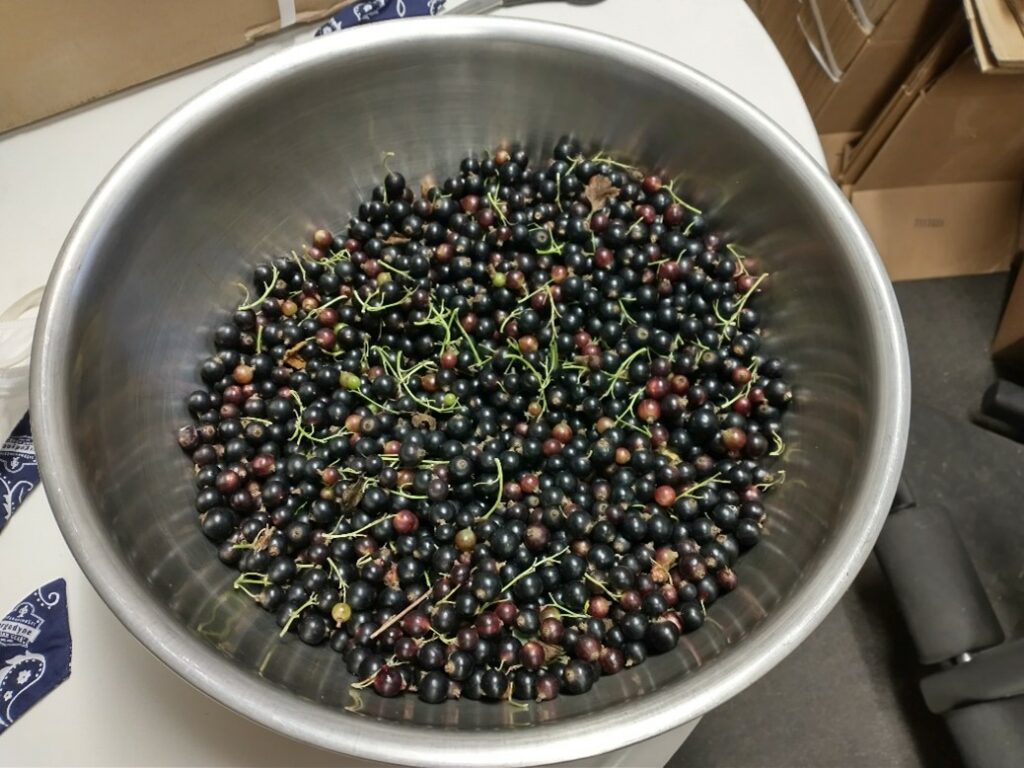It’s Berry Season

Summertime in the Northwoods is a delight of flavors. After the springtime pollination frenzy, berries delight us throughout the summer with their joyful flavors. On our farm, this includes varieties both domestic and wild…and a few hybrids.
In our smaller high tunnel behind our house, I had heeled in a few of our legacy strawberry plants when we let the old patch go because it had become so overgrown. I didn’t even cover them with straw, just tucked them into the soil and hoped they’d be alright. Over the past couple of years, these few plants have thrived amazingly well, sending runners in all directions. Now the whole center bed of that high tunnel is strawberries! These bloom earlier than the plants growing outside, which means we have handfuls of fresh, juicy red berries to enjoy at breakfast weeks before our field-growing strawberry friends are harvesting.
After strawberries come the raspberries and the red currants. Our three little intrepid red currant bushes are slowly growing bigger and stronger. A thornless shrub, currants hold their glisteny round berries on small clusters that come from the older stems. Newer stems will take a few years of maturity before they flower and bear fruit. As the stems age beyond their bearing years, the canes lean outward and touch the ground, where they then root and start new plants, expanding outwards. The maturing canes on our red currants bore just enough fruit to make a double batch of rhubarb red currant preserve (yum!), which has been a popular new flavor for folks to order from our shop.
Our raspberry patch was started by Grandma and Grandpa well before we moved up north to take over the farm, and we’ve expanded and moved the patch over the years, adding new stock from a friend for variety. Each spring, I break out the old canes that have died to make room for the new ones coming along. But over the past few years, it seemed the patch was dying out, and we thought perhaps it was time to retire this bed.
Last fall, as we brought the poultry in out of the pasture, we fenced in the raspberry patch for our breeder flock of turkeys. They adored searching through the canes for anything entertaining to a turkey, like feathered safari hunters on the prowl. They dug dust holes, trounced paths, and delighted themselves with this spot. Then, this spring, up sprang the raspberries with renewed vigor and spunk. This summer, Kara’s been able to collect bags and bags of the precious, ruby fruits for making her signature triple berry sheep milk gelato. Hooray!
Nearby to the raspberry patch is a lush stand of while chokecherries. Around the base of the stand grow wild raspberries, but this year we noticed a difference in the fruits. Instead of the tiny, beady berries of the wild raspberries beside the creek, these were larger and cup-shaped like the domestic ones, yet they retained more of the flavor of the wild fruits. They must be lovechildren of the two varieties.
The chokecherries themselves will come a little later this summer, as their clusters of round fruits are still ripening towards their shiny blackness. Called chokecherries because they are outrageously tart, these fruits bear a pit like any other cherry. Chokecherries grow as tall shrubs, sprouting from a crown, while their accompanying friends the pin cherries (still tart but not quite as much) grow as a tree. We have both on the farm, and they typically ripen about the same time. Chokecherry jam is a special treat with regional renown. When it’s in season, be sure to bake some hot biscuits and enjoy!
Right now, it’s black currant season. Our four black currant bushes (which have now grown and spread and comingled into one great bank of currants) started as tiny little sprigs from Lee Stadnyk’s farm up by Ashland, WI. I was in a summer sustainable agriculture course through Northland College, which professor Stadnyk spearheaded. He had several rows of black currants, which he grew for local wineries, and near the end of the course he dug up a few that had rooted in the walkways for me to take back to my farm. These have grown and flourished, and this year they decided to yield a bumper crop.
Tangier than the red currants (though not quite as tart as a chokecherry), these round fruits pack a solid antioxidant punch. Kara’s planning to create a new fruity gelato flavor with them this year, so I needed to beat the birds and the storms to the crop. I headed out with a large bowl, but after more than an hour of picking, it was soon apparent that this was going to be a multi-session experience. Last night, just before the rainstorms arrived, I braved the onslaught of mosquitoes to pick the last large bowl of fruits, so Kara is going to have quite the haul for gelato festivities.
Near the currants, we have two rows of blueberries. Winters have been hard on them, yet they persist, and the azure jewels are so delicious. Our berry growing friends in Bayfield also help us stay supplied with hundreds of pounds of blueberries for pies, muffins, and gelato.
As August matures towards September, it will be blackberry season, and the brambles that line our lane will be ready for picking. Right now, they are loaded in green fruits, so we’re all hoping there will be enough rain for them to plump up as they mature. Yum!
Do you have a favorite berry? Take some time this summer to go picking and enjoy the harvest. See you down on the farm sometime.






